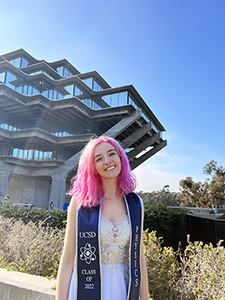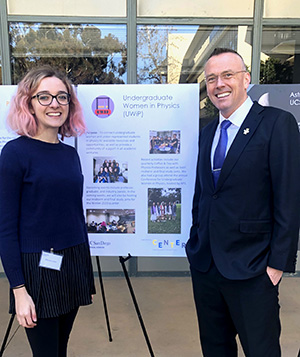Alumni Spotlight: Mikaela Larkin
January 6, 2023 | By Michelle Franklin
Mikaela Larkin graduated last spring with a B.S. in physics with a specialization in astrophysics. During her time at UC San Diego she was the lead author on the paper, “Characterization of Population III Stars with Stellar Atmosphere and Evolutionary Modeling and Predictions of their Observability with the JWST,” recently published in The Astronomical Journal. Read more about the paper and Larkin’s time at UC San Diego in this spotlight Q&A.

Q: Why did you choose UC San Diego?
Mikaela Larkin: I knew I wanted to study astrophysics and I wanted to stay in Southern California. UC San Diego is such a great school for STEM. It seemed like a great school for me — far enough from home but not too far. It all came together really well for me.
Q: How did you become interested in astrophysics?
ML: Since I was young, I’ve been really fascinated by space. I enjoyed sci-fi movies and liked the idea of learning about the reality of space when there’s so much that people theorize about it. I wanted to know how space works and why it is the way it is.
Q: Your paper is about Population III stars. What are they?
ML: Population I stars are the “modern stars” we see today; Population II stars are the previous generation of stars that are mostly hydrogen and helium but do contain some metals. Those stars have been directly detected. Population III stars are the very first stars created after the Big Bang. They haven’t been directly observed before because they wouldn’t have lived for very long. They were composed of almost entirely hydrogen and helium before new metals started being introduced in the universe. Population III stars help our understanding of how stars are composed today. This generation of stars would have had to exist, they just haven’t been directly detected.
Q: You say they didn’t live very long, but with stars “not long” could still be a million years.
ML: It is still a long time compared to human life, but in the span of cosmological history, it’s a very short time period. The universe has existed for 13-14 billion years, so this would have been only in the millions of years that Population III stars would have been present. It’s a very small fraction of cosmological history. Since Population III stars haven’t existed for billions of years, they are very faint and difficult to detect. We have to look at the deep reaches of space to see them, which means we are looking back into the past.

Steve Boggs.
ML: We used an atmosphere modeling software called ATLAS with the help of one of Professor Adam Burgasser’s graduate students, Roman Gerasimov. It’s an older software that Roman has made compatible with Python. We first ran tests to see if the software could simulate Population III atmospheres. With the help of the San Diego Supercomputer Center, we made models of what these atmospheres would look like and how they would evolve. Then we used the transmission profiles from the James Webb Space Telescope (JWST) to see how the stars would appear and make plots of what they would look like if that telescope was able to detect them. Basically, we took our models and paired them with this telescope to give the best picture of how the stars could be directly observed for the first time.
Q: Is the hope that the JWST will be able to show a Population III star?
ML: That’s what we’re hoping for! There need to be favorable conditions, and the Population III stars need to be the biggest and brightest, but it is possible. Previous telescopes couldn’t see anything that faint so it’s pretty exciting that JWST has a chance for the first time.
Q: Was anyone at UC San Diego especially impactful during your time here?
ML: For this project in particular, Roman was incredibly helpful through the whole process. The project was his idea, and it was just the two of us working on it most of the time. He showed me what it was like to write a paper, to be in graduate school — he was incredibly helpful through all that. And of course, Professor Burgasser for overseeing everything and making sure we were on track and had the best likelihood for being published. They both definitely afforded me some pretty great opportunities as an undergraduate. It made me feel more included in the scientific community to have this project to work on.

Q: What is your favorite spot on campus?
ML: Art of Espresso!
Q: What are your favorite memories from UC San Diego?
ML: My freshman year I didn't really know anyone here. My assigned roommate Trinity and I became immediate best friends. We had the same major, we liked the same things, we were both from LA. We took all the same physics classes together and stayed roommates and best friends all these years.
The friends I made along the way were one of my main highlights. I also enjoyed being involved in Undergraduate Women in Physics (now Marginalized Identities in Physics). Since there are so few women in the field, it was nice to immediately have this group of fellow women in physics to help encourage me along the way.
Q: What are you reading / watching / listening to right now?
ML: Once I submitted the paper for review, I did some traveling. I followed my favorite band on tour — My Chemical Romance. They played in LA at the Forum for five nights, so I went to all those shows. I also saw them in Oklahoma, New York, New Jersey, Oregon, Washington and Nevada (twice).
